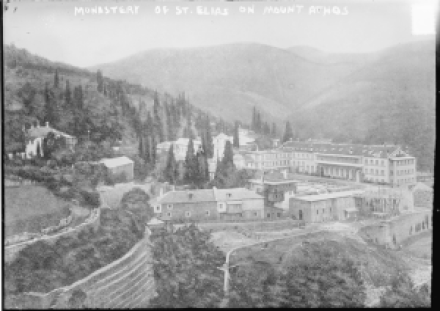
The Russian Skete before the central church was build.

With church build between 1899 and 1914. Foto from keliotes website.
Journalist Dave G. Houser writes about his recent visit to Athos especially about Skete. Prof. Eliou:
Brother Job invites Aris and me to stay at Prophet Elias and, obliging, we hike along behind Job on his tractor, towing a much-relieved monk up through scrubby hillsides covered with patches of gardens and vines. I spot tomatoes, cucumbers, squash, corn, peas, beans and artichokes. There are apricot and olive trees and grapes.
The high-domed monasteries of Mount Athos are, for the most part, true architectural gems. Fine brickwork was Byzantium’s calling, and it is evident everywhere.
Built by Russians in the 18th century, Prophet Elias is relatively new to Mount Athos, but it is a splendid example of the traditional arch-and-dome Byzantine style. It was built to accommodate almost a hundred monks, but during Soviet times in Russia, so few monks came to Prophet Elias that it faced abandonment. Then a small group of monks from upstate New York came to Athos to rescue the skete.
”It is good that we could come and help preserve this wonderful space,” says Job, the only resident of the skete now willing to talk to me ”on the record,” since word is out that I’m a journalist, “and, as you can see, it is like heaven on Earth here.”
That’s hardly an overstatement. With its bountiful orchards and gardens, its winery, olive mill and old stone bakery, Prophet Elias could pass for a rustic Tuscany estate — the kind you can rent for $5,000 a week. But it costs us nothing to stay here.
This is what happened in 1992 in the Skete where at that moment a few old Russian monks were living:
A delegation of greek monks, police, members of the Epistasia and others came to the skete and asked the Russian leader of the skete, Fr. Serafim if the patriarch was commemorated in the skete church services. When Fr. Serafim said no, all the residents were expelled. They were given a few minutes to gather their essential belongings before being transported by jeep and police speedboat to Ouranoupolis. A week later greek monks from Xenophontos Skete of the Annunciation moved in and from that time this Skete erected in 1763 by Russians was Greek.
There was a lot to do about this affair: in court but also protest from Greek newspapers and some Athonite monks. (source: Nicholas Fennel, The Russians on Athos)

Foto by Wim Voogd 2007
hv
